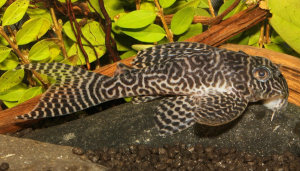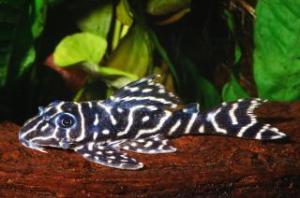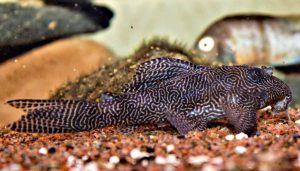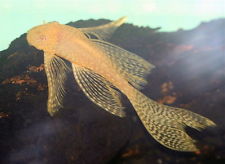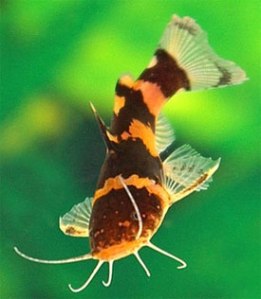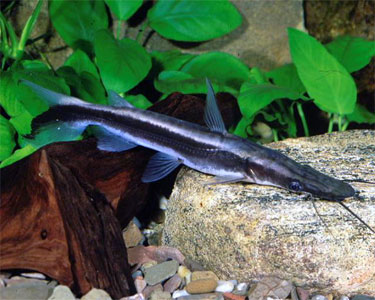I have acquired several Catfish Species for breeding. I have decided to eliminate my molly line in favor of these wonderful and interesting species. The molly line were nor reproducing for me and it they just weren’t economically feasible. Because I am a hobby breeder and not set up for display it just doesn’t make any sense to keep molly’s around that are not producing off spring or fry to sell. The following is alist of catfish I have acquired to start breeding. I will incorporate them into my breeding program with the other Catfish I raise. The descriptions I used are not my own writing but something I copied from the internet. I hope they don’t mind it comes from somewhere in Sweden, well most of them anyways!
HYPANCISTRUS sp. L400
By now, most enthusiasts will have noticed the level of uncertainty that surrounds the proper identification of the worm lined Hypancistrus forms from Belo Monte, Rio Xingu, Brazil. There appears to be evolution in the making with new forms separating into new species, and these forms also prove to be highly variable when bred in captivity. Hypancistrus sp. L399 and Hypancistrus sp. L400 were initially presented as two separate forms from the same area, but it has later turned out to be very hard to separate these two l-numbers from each other due to the variability within both of them. They are among the most beautiful of all l-numbers with their black markings against a light body, and they are kept by numerous breeders worldwide. Because of their similarity to other Xingu-based forms, crossbreeding is a high risk. For now, they are not allowed for export from Brazil, so captive breeding stock is required to maintain the existence of these beauties in the hobby.
Facts:
Name: Hypancistrus sp. “L400”
Trade names: L287, L400,
Origin: Rio Xingu, Brazil.
Maximum size: 12 cm / 5”
In the original presentation by Werner, L400 was presented as a slightly less elongate, smaller (10-12 cm) form than L399. Also, L400 is usually showing a pattern of spots and blotches, whereas L399 may often show a pattern of stripes and short lines, not unlike L66. Wild imports have since shown a huge variation where individuals overlap these traits in every way. It seems likely that they all represent the same species, which could even turn out to be the same species as L66, L173 and L236. The differences in appearance may be the result of local adaptations to certain conditions in the rapids and pools where these fish are found. Compared to L66, L400 has a less massive bodyshape, and the caudal fin is usually more forked too. L66 grows significantly bigger., and L400 is usually showing a pattern that is not dense, long lines like L66 has. Compared to L174, the spotted varieties of L400 has bigger eyes, a more elongate body and a larger adult size.
HYPANCISTRUS debilittera L129
Scientific Name: Hypancistrus debilittera Armbruster, Lujan & Taphorn, 2007
Common Name(s): L129
Type Locality: Pasaganado, 38 kilometers north of San Fernando de Atabapo, 4°23’04”N, 67°46’28”W, Río Orinoco, Amazonas, Venezuela
Pronunciation: hype an siss truss
Etymology:A contraction of the Greek hypo (meaning less than) and ancistrus, an allusion to the reduced number of teeth (particularly in the lower jaw) found in this genus. A combination of the Latin debilis meaning weak and littera meaning letter, in reference to the weak or absent E on the snout.
Jump to next section Species Information
Size: 2.8″ SL. Find near, nearer or same sized spp.
Identification: Dark brown base coloration with fine yellowish stripe. Rather large eyes compared with the body length (like Hypancistrus inspector. A small mouth with typical Hypancistrus dentition.
Sexing: Typical of the genus; males have longer pectoral and interopercular odontodes, they also have plate odontodes on the body. Females are rounder in the ventral region.
Habitat Information:
Distribution: Rio Bita, tributary of the Rio Orinoco, up of Puerto Careño, Colombia
Orinoco, Middle Orinoco, Bita (click on these areas to find other species found there)
pH:6.4 – 7.6
Temperature: 75.2-82.4°F (Show others within this range)
Jump to next section Husbandry Information
Feeding: Omnivore. They still seem to prefer meaty foods such as blood worms, gammarus or brine shrimps. Commercially prepared food such as Spirulina tabs are also eaten.
Aquarium Steup:Fine sand, driftwood, slate and/or bamboo caves. Plants can be kept without fear of damage from this species.
Compatibility: Its small size makes it a good citizen for small tanks. Males are more territorial than females and are territorial toward conspecifics and other Loricariidae of about the same size.
Suggested Tankmates: Small tetras and other similar small fish. Also Corydoras. Care has to be taken to ensure that they get enough food, as they can be a bit shy and slow to grab food when available.
Breeding: Females lay about 20 eggs of about 3mm in diameter in a cave. Brood guarded by the male in the cave. Raising of the young is unproblematic if a good hygiene is provided.
HYPANCISTRUS sp. L411
For some time this species was known as H.sp.“Monte Dourado”, named after the city near it’s natural habitat in Rio Jari, Brazil. These days it’s slowly diminishing in the hobby, as no new wild stock is supplied to the trade. L411 is not allowed for export from Brazil, and there’s no commercial fishing going on in Rio Jari any more. As with several other species, L411 was somewhat taken for granted before, and considered an easy to breed / hard to sell Hypancistrus in the great mix of choices. Now it’s kept in the hobby only by a few enthusiasts.
Facts:
Name: Hypancistrus sp. “L411”
Trade names: L411, H.sp.“Monte Dourado”
Origin: Rio Jari, Brazil.
Maximum size: 14 cm / 6”
This species can be confused with L260 from Rio Tapajos. However, L411 grows larger and has an even denser pattern of thinner lines.
In young fish, the pattern of L411 can be very striking, with clear, black lines against a very light, golden body. Some individuals show a mutated pattern of fewer black lines. Adult specimens, males in particular, can become very grey and dull coloured with their body almost covered in odontodes.
They need an aquarium set up consisting of lots of hiding places in the form of rocks, wood and of course specially made caves that suit their measurements. In these the males will eventually guard their offspring. They prefer water that is fairly warm (27-30 C), soft and slightly acidic. Most of all it should be well oxygenated and clean, so a good filtration system and frequent water changes are essential. Among themselves they are fairly peaceful, although males may quarrel for caves and females can sometimes be badly injured or even killed during the breeding-trapping in the male’s cave. Males develop longer odontodes on their pectoral fins and on their cheeks, and have broader heads. Hypancistrus are mostly carnivorous, so a selection of crustaceans, insect larvae and fish meat should be offered along with high quality dried foods that also contain some vegetable matter.
Although it’s difficult, one should always strive to keep separate lines of L399/400 apart.
They need an aquarium set up consisting of lots of hiding places in the form of rocks, wood and of course specially made caves that suit their measurements. In these the males will eventually guard their offspring. They prefer water that is fairly warm (27-30 C), soft and slightly acidic. Most of all it should be well oxygenated and clean, so a good filtration system and frequent water changes are essential. Among themselves they are fairly peaceful, although males may quarrel for caves and females can sometimes be badly injured or even killed during the breeding-trapping in the male’s cave. Males develop longer odontodes on their pectoral fins and on their cheeks, and have broader heads. Hypancistrus are mostly carnivorous, so a selection of crustaceans, insect larvae and fish meat should be offered along with high quality dried foods that also contain some vegetable matter.
From Wikipedia, the free encyclopedia
Ancistrus sp. Long Fin Albino Bushy nose
Several people have asked me for Long-fin Albino Ancistrus sp. so I have acquired some from a local fish farm, along with a few other catfish species including the following. I am setting up a large 55 Gallon tank for the later! More descriptions later!
Bumblebee Catfish – South American
Microglanis iheringi
Type/Environment: Freshwater; demersal
Climate: Tropical—Egg Layers
Taxonomy: (Gomes; 1946)Bumblebee catfish may refer to the entire family Pseudopimelodidae. Many species of Pseudomystus may be referred to as bumblebee catfish. or false bumblebee catfish. This name may also refer to a number of different catfish species with colouration reminiscent of that of a bumblebee:
Origin & Distribution: South America; Venezuela, Columbia
Description: Its common name of the Bumblebee Catfish can be misleading as there is another catfish, from Asia, Pseudomystus siamensis, that also carries this name and has a different body pattern, shape, and possess’s an extra pair of barbels. As its common name suggest it has dark brown markings on a light brown body. Dorsal fin is rounded and mainly dark brown with a pale tip. The caudal fin has a broad dark brown cross band. The bumblebee catfish will rarely come out at day from it’s hiding place, except for feeding time.
Color Form: As its common name suggest it has dark brown markings on a light brown body.
Sexual dimorphism: Females are noticeably plumper than males.
Size/Weight/Age: 5-7 cm
Lifespan: 3-5 years
Habitat: Fast flowing rivers
Diet / Feeding: Omnivorous; tablets, flake food, frozen foods of all kinds. Any small live foods such as daphnia and mosquito larvae. In nature the species consumes insects and their larvae.
Breeding / Reproduction: Very rare in aquarium. Breeding is very hard, only a few reports are available, try the following water parameters: 4.8-6 pH, with a temp of 22-25 °C. Feed the fish with varied live foods, such as Daphnia, bloodworm and river shrimp. A drop in temperature then a quickly warming up can be initiate to their spawning.
Aquarium Setup: Plant the tank generously and provide room for swimming and feeding with a sand substrate. Hiding places from rocks and roots is necessary.
Minimum School Size: Population: 3 fish for 75 litres
Minimum Tank Size: Minimum 60 litres
Care Level:
Water Conditions:
- Temperature: 21-26 °C
- pH: 6.5-7.5
- Hardness: 10-18 NK°
Swimming Level: Bottom
Compatibility / Temperament: Quiet, peaceful, nocturnal catfish, who only occasionally considers young offspring resting on the bottom as nourishment. An ideal addition for the well arranged community tank.
Long-nose Twig Catfish Plus (3) Albino’s of this species
Farlowella gracilus
Synonyms: They go by a variety of common names within the aquarium hobby including: Longnose Twig Catfish, Twig Catfish, Whiptail Catfish and Slender Armored Cat. Farlowella boliviana
Type/Environment: Freshwater; demersal
Climate: Tropical—Egg Layers
Taxonomy: Regan, 1904; The Loricariinae is a subfamily of armored catfishes comprising more than 31 genera and 209 species (Ferraris, 2003). Fishes assigned to this subfamily are generally recognized by being strongly depressed, elongate, and lacking an adipose fin. Genera of the Loricariinae are outstandingly rich in morphological variation, which has led to the recognition of several monotypic genera (Covain & Fisch-Muller, 2007). A few genera include moderate to large numbers of species, and some of them are found in cis-Andean areas (Farlowella, Harttia, Loricariichthys), while others occupy both cis- and trans-Andean drainages (Rineloricaria, Spatuloricaria and Sturisoma). One of these genera, Farlowella, is the second richest genus in the subfamily with 26 species (Retzer, 2006). The genus Farlowella Eigenmann & Eigenmann was revised by Retzer & Page (1996) who proposed an intrageneric arrangement of species groups. These authors provided information on the taxonomy and geographic
Origin & Distribution: Longnose Twig Catfish (Farlowella gracilis) is a popular species of armored catfish originating from the tropical river basins of Colombia.
Description: Farlowella gracilis is a species of armored ca fish endemic to Colombia where it is found in the Caqueta River basin.
Physical Characteristics: Anterior plates on median row hexagonal in shape. Farlowella differ from the other Loricaria fish in the positioning of the dorsal fin which is normally opposite the anal fin but on Farlowella it is behind the anal fin.
Sexual dimorphism: Males have a broader rostrum (snout) and develop rows of bristle-like odontotes along it as they mature.
Size/Weight/Age: This species grows to a length of 17.8 centimetres (7.0 in) SL.
Lifespan: They are believed to have a lifespan of up to 15 years. They are also known for being a long lived and very hardy species once acclimated in the aquarium environment.
Behavior: Longnose Twig Catfish perform an important role within the aquarium ecosystem by keeping excess algae in check and helping to keep the aquarium substrate free of decaying plant material and excess foodstuffs. This fish is truly a camouflage expert among aquarium fish; hanging or sitting motionless on a branch they are easily unnoticed, as illustrated in the first photo above. They move from surface to surface, usually with short “hops;” swimming when necessary is achieved by body undulations and propulsion from the caudal fin.
Habitat: The native tropical river habitat of the Longnose Twig Catfish consists of slowly moving waters that typically have a sandy or mixed rock and sand substrate with submerged tree root and vegetation near the river banks. Fish species originating from river habitats are typically used to clean, highly oxygenated waters and a good amount of water currents.
Diet / Feeding: The Longnose Twig Catfish is an omnivorous species that requires both plant and meaty material in its diet in order to thrive and to maintain a healthy immune system. They will consume naturally occurring algae from within the aquarium, grazing on the aquarium glass, substrate, rocks and driftwood. They will also consume leftover meaty foods that are present on the aquarium substrate. However, in most cases the Longnose Twig Catfish will also require additional feedings as there will not be enough to food to support them through scavenging only. Hobbyists should provide additional feedings of blanched vegetables like zucchini or squash, sinking algae wafers, shrimp pellets and other sinking pellet foods designed for substrate scavengers. They are mostly vegetarian with algae being their number one source of food for adults and young fry so the above mentioned foods along with vegetable laden tablets should suffice.
Breeding / Reproduction: Spawning in Whiptail Catfish varieties occurs in hollow tubes, and then the male fish safeguards the eggs subsequent to driving the female fish away. The broods are smaller in size, usually less than 100 eggs. The fry hatch following a week, but will drain their yolk sac only after one or two days. Once this takes place, the fry will consume liquid fry food, algae and very delicately crushed flake food. The male will clean a spawning site and the female will lay the eggs normally in the evening. The male will fan the eggs and in 6-10 days they should hatch. This is now a critical time for saving the fry. They must be fed immediately with vegetable matter and Infusoria. There is usually a high mortality rate with these fish.
Aquarium Setup: Usually, Whiptail Catfish varieties prefer aquariums that have high ventilation and water movement to create a healthy atmosphere. Driftwood and Rocks assist them to accent an innate habitation and offer them hiding places to reduce their pressure and to offer them an immense shelter. An aquarium with a minimum capacity of 50 gallons or a bigger tank is suggested for this fish variety. Many hobbyists keeping tropical community aquariums or Amazon biotope aquariums keep Longnose Twig Catfish both for their attractive appearance and their ability to consume algae and detritus. Hobbyists should look to replicate these water conditions by providing additional dissolved oxygen and water flow via strong filtration water returns or power heads. Ideally submerged root, driftwood, rocks and plants should be provided to create a more natural habitat and provide additional places for the Longnose Twig Catfish to feed on algae.
Minimum Tank Size: 40 Gallons
Care Level: Moderate This species is best kept by intermediate or above hobbyists with established community aquariums, planted aquariums or Amazon river biotope setups. Not an easy catfish to keep as there have been many unexplained deaths attributed to this species (and other Farlowella) and as such would need dedicated care from an experienced catfish keeper who has worked with this species or its close cousins from the easier kept Sturisoma genera. As this is a very timid species, if housed with other inhabitants you would be better keeping away from boisterous fish such as some of the Barb species (such as tigers) and definitely Cichlids. Better companions would be the unobtrusive Corydoras species and small Characins or Rasboras. Needs a high oxygen content in the aquarium with regular water changes to keep the water in pristine condition. Prefers a dark substrate with a dense vegetation and floating plants.
Water Conditions:
- Temp: 72-80° F
- pH:pH 6.5-7.8
- Hardness:KH 4-10
Swimming Level: Bottom
Compatibility / Temperament: Peaceful; Tank mates should include peaceful community fish species (tetras, barbs, gourami, danios, cory cats, loaches) and smaller more peaceful Cichlid species (convicts, firemouths, rainbows, angelfish, smaller catfish).
Remarks: The identify of members of this genus is carried out by looking at the ventral plates (underneath the mouth to anal area) to identify to species. F.gracilis has five rows of anterior lateral scutes; scutes in second anterior lateral row hexagonal. A unique combination of derived characteristics: pectoral fin short, ratio of pectoral fin length to distance from pectoral fin origin to pelvic fin origin < 0.9; head square (rather than triangular). This species has also very long extensions to the caudal fin.
Whip-tail Catfish
Rineloricaria eigenmanni
Type/Environment: Freshwater; demersal
Climate: Tropical—Egg Layers
Taxonomy: Rineloricaria (from the Greek, rhinos meaning nose, and the Latin, lorica meaning cuirass of leather) is a genus of freshwater tropical catfish (order Siluriformes) belonging to the Loricariidae family. This genus was described by Pieter Bleeker in 1862, with R. lima as the type species. This genus is by far one of the most specious of the subfamily Loricariinae, containing about 30 species. On the other hand, it is one of the least resolved genera. In 2008, 14 new species were added to this genus. It does have a bit of a confusing taxonomic past, though. Whilst currently considered a member of Rineloricaria, it was first described as a species of Loricaria, before being moved to Rineloricaria in 1908. In 2002 it was briefly placed in the resurrected genus Hemiloricaria, but this lasted less than twelve months, when it was transferred back to Rineloricaria. Currently only Rineloricaria is valid, but you’ll still see it being referred to as Hemiloricaria quite often. As if that lot isn’t enough, it’s also regularly mixed up with other species, too.
Origin & Distribution: Colombia and Venezuela; They are native to the rivers of Northern and Central South America but are imported to other countries as household aquarium pets.
Description: The best way to identify it correctly is to look at the patterning on the fins and the underside of the extended caudal peduncle. If you’re looking at a Rineloricaria eigenmanni, you’ll see that the black bars running across the caudal peduncle continue right around the fish, forming bands, and that the fins are barred. No other member of the genus combines these features.
Physical Characteristics: They are commonly called whiptail catfish because of the long filament that grows out of the tip of the caudal fin that is characteristic of the genus.
Sexual dimorphism: Mature males develop odontotes on the head and pectoral rays, which are lacking in females.
Size/Weight/Age: 6″ (15cm).
Behavior: One of the most peaceful catfish around, these can be combined with many other species. In a biotope setup, good tank mates include small characins, Apistogramma, Corydoras and other quiet Loricariids, but it can be kept in most communities of peaceful fish. Don’t keep it with anything too vigorous or aggressive, as it will become very retiring and will easily be out-competed for food. It’s not territorial unless spawning and is best kept in a small group.
Habitat: It’s almost always found living amongst leaf litter over sandy substrates, in both clear and whitewater habitats (whitewater meaning water containing a lot of dissolved sediment, as opposed to rapids).
Diet / Feeding: Feeds on aufwuchs and small aquatic crustaceans in nature. In the aquarium, it proves omnivorous and will accept sinking dried foods, vegetable matter (including blanched spinach, courgette, kale etc.) and live and frozen stuff, such as bloodworm or daphnia.
Breeding / Reproduction: If kept in suitable conditions and fed well, the fish will breed quite easily. The fry can be a little tricky to raise. Try starting with a group of six or more juvenile fish to give yourself the best chance of obtaining a pair. Set up the tank as suggested above, using lengths of pvc piping of less than 2″ diameter to provide spawning caves. The water should be just on the acidic side of neutral and soft. Condition the fish on a diet of nutrient-rich greenstuffs, such as kale, spinach etc. and live and frozen bloodworm or similar.
When in spawning condition, a male will select a particular cave and clean it carefully. A receptive female will visit this cave and deposit her eggs, which the male then fertilizes. The female then plays no further part in brood care, with responsibility for the guarding and tending of the eggs falling solely to the male. This he does diligently, guarding the cave against intruders whilst fanning the eggs with his fins. At this point, you may wish to remove the other fish, or indeed the tube itself to a separate tank, in order to avoid predation of the fry.
The eggs hatch in 4-5 days and are free swimming 2 or 3 days later. At this point, the male can also be removed. They will browse on cucumber slices, spinach and other greens straight away and will also take micro-worm and brine shrimp nauplii. The most important thing at this point is that the fry don’t starve. They need constant access to a food source and any vegetable matter must be of a consistency soft enough for them to digest. Try pre-softened leaves of kale and spinach (it’s better to soften these by soaking them in water for a couple of days, rather than blanching in boiling water, as this tends to strip many of the nutrients away). Algae grown on rocks in a sunlit tank can also be offered. They are also sensitive to water quality, so small daily water changes are recommended. If you’re having trouble spawning these fish, try conducting a large (50-70%) water change with cool water, simulating the infux of colder water that the rainy season brings in nature. Repeat every few days and the fish will often spawn.
Aquarium: Largely inactive and can be kept in a tank measuring 36″ x 12″ x 12″ (90cm x 30cm x 30cm) – 81 litres.
Aquarium Setup: A biotope setup can consist, very simply, of a layer of sand over which is scattered a layer of dried leaves (oak and beech are non-toxic and work particularly well). Some twisted branches (again, beech is good) and the occasional rounded stone can also be added for effect. Provide some rock or wood caves and lengths of pvc piping to act as potential spawning sites. It’s equally at home in a well-planted tank, although in either situation it won’t appreciate very bright lighting.
Water Conditions:
- Temp:
- pH:
- Hardness:
Swimming Level: Bottom
Compatibility / Temperament: One of the most common of the numerous species sold as ‘whiptail catfish’, R. eigenmanni is an excellent species for the newcomer to Loricariids or catfish breeding. It’s certainly not the most active species, but when settled and housed with the correct kind of tank mates, it is by no means shy either.
Sorubim lima,Lima Shovelnose
Duck-beak Catfish, Duckbill Catfish, Hockey Stick Catfish
Sorubim is a small genus of long-whiskered catfish native to tropical South America. A number of characteristics allows the differentiation of each species in the genus. Sorubim species are important food fish in South America and are highly significant to fisheries of some areas; however, harvests of these fish are not identified as much as other, more popular food fishes such as Colossoma, Arapaima, and Brachyplatystoma. Some species of this family are popular aquarium fish.
Taxonomy: The genus name is derived from a Brazilian local name, sorubí. The description of Sorubim has been attributed to both Cuvier and Agassiz in 1829, but because Cuvier’s description predates that of Agassiz’s by two months, Cuvier’s is valid. Later, Sorubim lima, originally described as Siluris lima in 1801, was designated as the type species by Bleeker in 1862.
In 2007, this genus was reviewed, validating five species. S. lima and S. trigonocephalus are redescribed in this paper. This genus is monophyletic.
Species: The currently recognized species in this genus are:
- Sorubim cuspicaudus Littmann, Burr & Nass, 2000 (Trans-Andean Shovelnose Catfish)
- Sorubim elongatus Littmann, Burr, Schmidt & Isern, 2001 (Slender Shovelnose Catfish)
- Sorubim lima (Bloch & Schneider, 1801) (Duckbill Catfish)
- Sorubim maniradii Littmann, Burr & Buitrago-Suárez, 2001
- Sorubim trigonocephalus Miranda-Ribeiro, 1920 (Arrowhead shovelnose catfish)
Distribution and habitat: Sorubim is a widely distributed genus, collected from many major river basins in 10 countries. S. lima is the most widely distributed species of the genus, found east of the Andes in the Amazon, Orinoco, Parana, and Parnaiba basins. It is syntopic with S. elongatus in the Orinoco basin and with S. elongatus and S. maniradii in the upper Amazon drainage of Brazil, Ecuador, Peru, and Bolivia. S. maniradii was discovered in the Napo and Yasumi River drainages of Ecuador, but also occurs in other tributaries of the Amazon. S. elongatus is found in the Amazon, Orinoco, and Essequibo River basins. S. cuspicaudus is found in northern Colombia and inhabits Lake Maracaibo, Sinu River, Cauca River, and Magdalena River basins. S. trigonocephalus is the rarest of the genus; only three specimens have ever been collected, from the Tapajos River and the Madeira River.
Sorubim species are found in fast-moving and slow-moving waters, including lakes, rivers, and bays. Typically, the substrate is either sand, clay, or mud, associated with reeds, grasses, and roots. They are not found as often over substrates of strictly sand or mud. They are also not found as commonly in clearer blackwater habitats. S. elongatus occurs in both whitewater and blackwater, found in floodplain lakes and small creeks to large rivers. S. lima is commonly found in schools.
Anatomy and appearance: Sorubim species, like other catfish, possess dorsal and pectoral fin spines. They have a triangular adipose fin. As Pimelodidae, these fish have very long barbels, especially maxillary barbels, which range in length from reaching the pectoral fin to extending past the pelvic fins. Like some other pimelodid genera, these fish may have long filaments on their dorsal, pectoral, and caudal fins; in juveniles, these filaments may be even longer than the body. Sorubim is characterized by a shovel-like, projecting upper jaw with an exposed, villiform (brush-like) premaxillary tooth patch. The head is depressed and usually three times longer than it is wide. The eyes are set laterally and usually visible from below. They have a characteristic black, lateral stripe, variable in width, that extends from the snout to the end of the caudal fin; though this may seem minor, no other pimelodid has a lateral stripe that reaches down the entire length of the head and body.
Along with the lateral stripe, Sorubim species have a darkened dorsal surface, which is sometimes separated by a thinner, lighter-colored band. The dorsal surface may change its shade quickly with its surroundings. S. lima may also display dark blotches or spots on its dorsal surface. The ventral part of the body is white or cream-colored. Light areas may appear golden or slate gray, often appearing iridescent. Young fish are more heavily pigmented than adults. Posterior-most rays on dorsal, anal, and pelvic fins are elongated, darker, and heavily speckled with chromatophores; however, this speckling is reduced in the adults. This could provide camouflage when the fish are young and hiding among plant materials, and is lost when the adults live in more open water habitats.
S. lima appears similar to S. trigonocephalus; however, the latter has a long snout, pointed (triangular) head, and an exposed patch of premaxillary teeth that is as wide as it is long. S. cuspicaudus has a markedly different tail (straight, pointed, and long) in contrast to the other Sorubim with more rounded caudal fin lobes. S. maniradii is differentiated from the other species by a high number of gill rakers, ranging from 31-37, compared to the 13-23 of the other Sorubim species, as well as a more diffused lateral stripe. S. elongatus has an elongated head and body, and appears rather slender in comparison to the other members of this genus.
S. cuspicaudus is the largest species in the genus, reaching up to 80 cm (30 in). S. trigonocephalus and S. lima reach a length of about 50 cm (20 in). By contrast, S. elongatus and S. maniradii only reach about half that length, 30 cm (12 in) in the former and 25 cm (10 in) in the latter.
Ecology: Because of the natural whitewater habitats of these fish, which makes natural observation difficult, most observations of the behavior of this fish is largely known from study of fish in aquaria. Natural history and reproduction of this fish are not well known. When inactive, these fish often swim in a vertical posture, probably to help blend into stems of reeds and other aquatic plants; when active, they swim in a normal, horizontal manner. They may use this camouflage either to hide from predators or as part of ambush predation. These fish feed on fish and crustaceans, and as adults are largely piscivorous. Sorubim species have been observed in captivity to excavate a small pit as a nest and even to guard freshly hatched young (unfortunately, none of these young survived).
These fish are nocturnal and occur in groups or schools. In the aquarium S. lima has been in the aquarium trade for many years, and is the most common species found in the aquarium trade. S. elongatus also appears rather often, and is sold as S. lima.
This fish is lazy and slow-moving; being nocturnal, it will usually hide during the day. It will accept most food, but also can consume smaller fish. It is hardy, and the pH is not of great importance, but slightly acidic is best. This fish requires a large aquarium. This fish prefers a current as well as clean water. It has not yet been bred in captivity.

